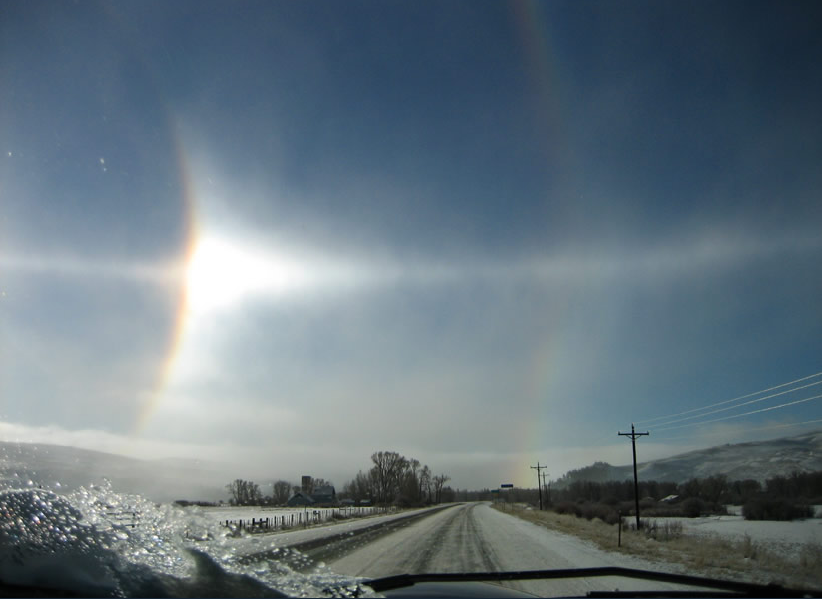Colorado Rockies Halos
Colorado Rockies Halos: A Phenomenon of Dazzling Beauty
The majestic Colorado Rockies not only offer breathtaking vistas but also play host to a mesmerizing atmospheric optics phenomenon known as halos. Halos are ethereal optical displays caused by the interaction of sunlight with ice crystals suspended in the atmosphere. While halos can occur in various locations around the world, the unique combination of weather conditions and geography in the Colorado Rockies creates a particularly stunning spectacle.
One of the most striking elements of the Colorado Rockies halos is the presence of sundogs, which are bright spots of light that appear on either side of the sun. These sundogs are caused by the refraction of sunlight through ice crystals in the atmosphere. In the Colorado Rockies, they often appear dazzlingly bright, adding an extra touch of magic to the already awe-inspiring scenery.
Another remarkable feature of the halos in this region is the parhelic circle, which courses horizontally across the sky. The parhelic circle is a circular band of light that appears parallel to the horizon and is caused by sunlight reflecting off horizontal ice crystals. This unique phenomenon adds a sense of depth and dimension to the halo display, creating a truly immersive experience for observers.
In addition to sundogs and the parhelic circle, the Colorado Rockies halos also exhibit supralateral and infralateral arcs. These arcs are strongly colored and appear twice as far from the sun as the sundogs. They are created when sunlight passes through side faces and end faces of horizontal column crystals. It is worth noting that these arcs are often mistaken for the much rarer 46° halo, further highlighting the exceptional nature of the atmospheric optics in this region.
The intricate interplay between sunlight and ice crystals in the Colorado Rockies gives rise to an array of halo variations. These include circumzenithal arcs, which form an upside-down rainbow near the zenith, and circumhorizontal arcs, which appear as colorful bands stretching horizontally across the sky. These phenomena, along with the sundogs, parhelic circle, and supralateral and infralateral arcs, create a symphony of light that captivates observers and leaves them in awe of nature's artistry.
To fully appreciate the Colorado Rockies halos, it is essential to understand the science behind them. The formation of halos requires specific weather conditions, including the presence of high-altitude cirrus clouds composed of ice crystals. These ice crystals act as prisms, bending and refracting sunlight to create the stunning optical effects. The unique geography of the Colorado Rockies, with its towering peaks and wide-open spaces, provides an ideal backdrop for these atmospheric displays to unfold.
Photographers and enthusiasts flock to the Colorado Rockies in search of these mesmerizing halos. Capturing the perfect shot requires patience, as the conditions for halo formation are not always present. However, when everything aligns, the resulting photographs are nothing short of breathtaking. The combination of the natural beauty of the Rockies and the ethereal halos creates images that evoke a sense of wonder and transport viewers to a realm where reality and enchantment merge.
In conclusion, the Colorado Rockies halos offer a captivating spectacle that showcases the harmonious dance between light and ice crystals. From the dazzling sundogs to the horizontal parhelic circle and the vividly colored supralateral and infralateral arcs, these atmospheric optics phenomena paint the sky with a palette of celestial beauty. Whether witnessing them in person or admiring photographs, experiencing the Colorado Rockies halos is a reminder of nature's ability to inspire awe and wonder in our lives.

Halo Display, Colorado Rockies Imaged by Chad Cardwell.
©Chad Cardwell, shown with permission.
At left is a dazzlingly bright sundog. The sun is off picture at far left.
A parhelic circle courses horizontally across the sky.
The strongly coloured arcs at right and twice as far from the sun as the sundog are supralateral and infralateral arcs. They are made by sunlight passing through a side face and an end face of horizontal column crystals. They are often mistaken for the much more rare 46° halo.
Note: this article has been automatically converted from the old site and may not appear as intended. You can find the original article here.
Reference Atmospheric Optics
If you use any of the definitions, information, or data presented on Atmospheric Optics, please copy the link or reference below to properly credit us as the reference source. Thank you!
-
<a href="https://atoptics.co.uk/blog/colorado-rockies-halos/">Colorado Rockies Halos</a>
-
"Colorado Rockies Halos". Atmospheric Optics. Accessed on April 23, 2024. https://atoptics.co.uk/blog/colorado-rockies-halos/.
-
"Colorado Rockies Halos". Atmospheric Optics, https://atoptics.co.uk/blog/colorado-rockies-halos/. Accessed 23 April, 2024
-
Colorado Rockies Halos. Atmospheric Optics. Retrieved from https://atoptics.co.uk/blog/colorado-rockies-halos/.